Farman F.190 Air France
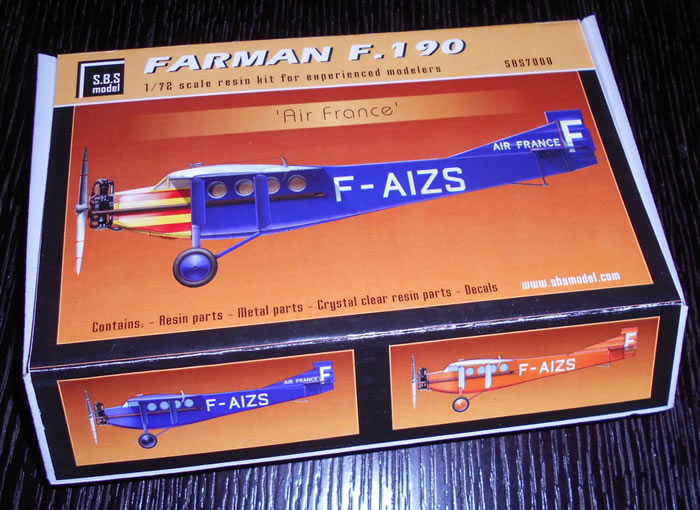
S.B.S. Model, 1/72 scale
S u m m a r y : |
Catalogue Number, Description and Price: |
|
Scale: |
1/72 |
Contents & Media |
A4 double-sided line drawing instruction sheet and parts map, A5 colour scheme and decal placement sheet, two larger clip-lock bags , one with the fuselage halves and wings, and the other with higgledy-piggledy mass of smaller parts - 67 in all, three smaller bags containing the nine clear resin transparencies, a 40x20mm PE sheet and instrument transparency and then the eight white metal parts, and a large decal sheet which appears beautifully printed.. |
Review Type: |
First Look. |
Advantages: |
Ssuperb quality casting with excellent detail and thoughtful construction ideas. Great decal choices, excellent instructions and strong packaging. |
Disadvantages: |
No colour information for the interior. |
Conclusions: |
This is a lovely kit of an important between-the-wars light aircraft. Care and planning in assembly and painting should result in a gorgeous addition to your collection. |
Reviewed by Graham Carter

SBS is a Hungarian producer of high quality kits of figures, vehicles, accessories and aircraft in variety of scales, all in resin. The kits are not cheap but the quality is superb based on the three that I have.
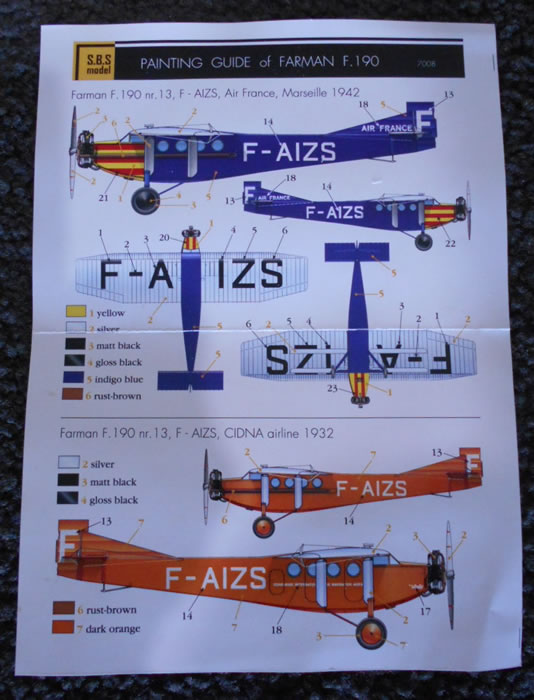
This is the Farman F190, a popular late 1920s to mid-1930s light aircraft. Almost 160 were built and it was extensively used by both military and civil organisations, including the incipient Air France. It could carry four passengers and the pilot, although some were used for freight and mail and even stretcher carrying. Some had slightly larger engines than the five-cylinder 230hp Gnome and Rhone 5Ba in this kit. Other versions had 6, 7 and 9 cylinder engines of up to 280hp.
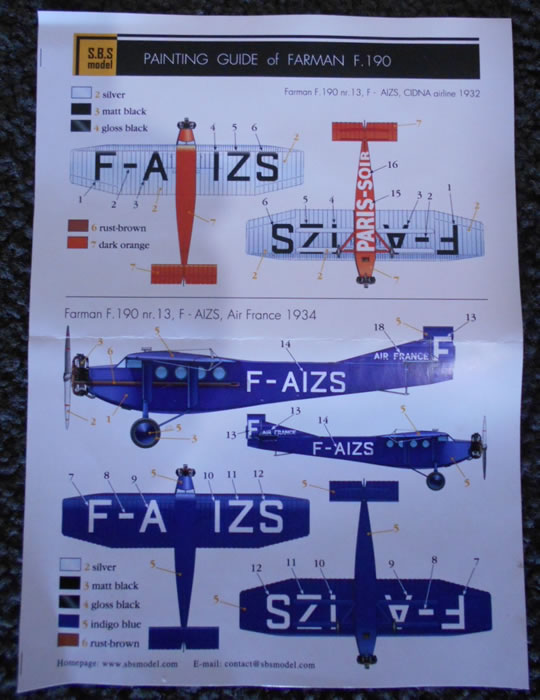
There is quite a lot of information on the ‘net but if you want a mass of detail then Air Britain’s quarterly Archive did a 22-part (!) series from number 4/2010 to number 1/2016. Some of the schemes illustrated in colour, along with B&W photos are quite enticing and if I could afford it I would build at least a half-dozen of these kits.
The kit has been issued in three boxing; this one, and versions covering its use in the Spanish Civil War/Portugal and in Armee de l’Air /Air Service use - only differing in decals. They range in price from 40 to 56 Euros on their current web-site, not cheap but you do pay for such quality.
The kit comes in SBS’s very strong top opening box which protects the contents very well. Inside there are:
an A4 double-sided line drawing instruction sheet and parts map, A5 colour scheme and decal placement sheet, two larger clip-lock bags , one with the fuselage halves and wings, and the other with higgledy-piggledy mass of smaller parts - 67 in all, three smaller bags containing the nine clear resin transparencies, a 40x20mm PE sheet and instrument transparency and then the eight white metal parts, and a large decal sheet which appears beautifully printed.
Cast parts are a mix of dark and mid grey resin and are to SBS’s superb standard - not a bubble or warp in sight. All parts are attached by fine webs to moulding blocks, while the fuselage halves use substantial pegs to prevent warping, although some care will be needed to remove these as they do impinge upon the mating surfaces.
The most delicate parts are cast inside little ‘cages ‘ to prevent damage - very clever. In fact I reckon there is almost as much resin in these blocks as in the past themselves! Each block has the part number embossed in it to aid construction. Surface detail is exquisite and the wings have a lovely scale rib effect. Tiny holes are located to help position struts and other parts.
The fuselage comes in three parts , two sides and an upper section with a built-in web to aid rigidity.
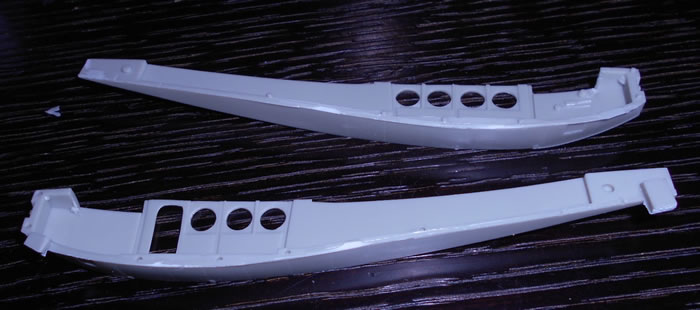
The cockpit is a nicely detailed unit with seat and belts, 2-part column, 4-part instrument panel with compass, 6-part side control console, rudder bar and seat adjustor. Behind that comes three bulkheads that divide the cabin into two two-seat sections made up of a door, floors and double seats. The door can be left open so that all the interior can be seen. The clear resin windows fit into recesses in the fuselage interior halves and will have to be attached early so that the interior can be painted. Speaking of which, unfortunately no information is given of the likely colours so I will be going with some typical soft greys and beige from the era.
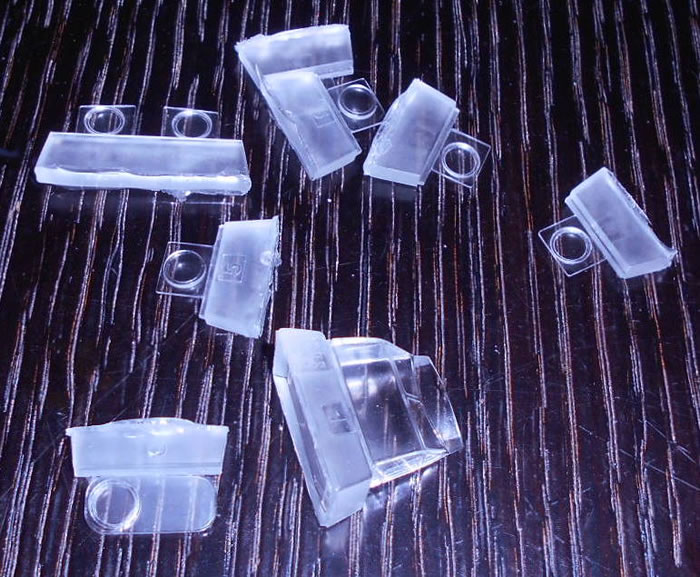
Careful separation of the fuselage halves from their blocks will need a bit of cleaning up. There are holes and pins to help assembly. The empennage is made up of three fixed surfaces with fine rib detail and three moving sections which have PE control horns. These are tiny and there are no spares so I would cut them from the fret inside a plastic bag to prevent the carpet monster getting a snack! The tail skid is made up of a double PE piece.
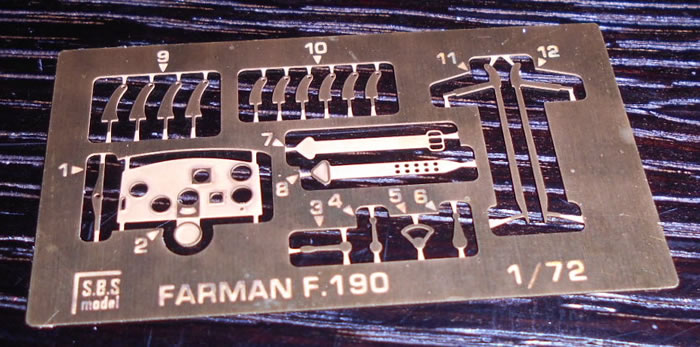
The large main-planes have locating holes and pegs cast into their mating surfaces and, having zero incidence, can be glued together on a flat surface. I don’t think they will need any wire reinforcing as they are attached across the top of both fuselage sides and a the clear windscreen casting has the top of the fuselage added at the rear to mate with them for a strong joint.
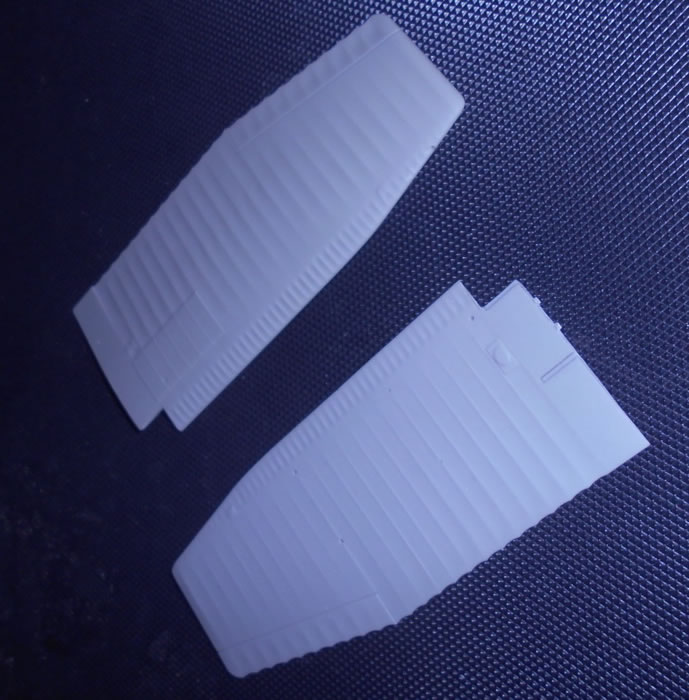
Next comes the struttery!
Four resin ones for the tail section and a combination of resin and white metal for the main planes. The modeller will need to make four small sprue or with rods for the tail struts by trial and error as no dimensions are provided and the head-on view is not 1/72.
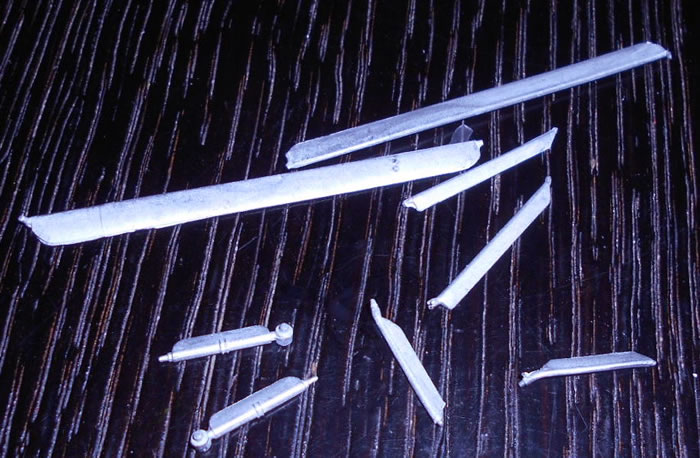
SBS has used an excellent technique by making the undercarriage struts and supports in white metal to add strength in this area as the aircraft is reasonably heavy and could make resin struts sag over time. The complex wing/fuselage/undercarriage set-up is covered in four separate drawings to show the location, angles and relationships between these struts - all sixteen of them! Location holes are provided that will ease the construction
Lastly the five-cylinder engine consists of seventeen beautifully cast parts with separate cylinders and inlet and outlet pipes. Careful construction and painting will be rewarded here.. Final parts are the propeller, cabin heater pipe and the long exhaust which will require some care as it has to be threaded through the struts and along the fuselage and joined up to the collector ring at the front. Probably a job left until after painting.
Markings and Instructions
Painting will be an interesting challenge, especially if you by-pas the overall blue scheme, as the struts are combination of silver and either orange or blue. The giant serials across the underside of the wings make it imperative that the major components are assembled and painted before attaching the struts.
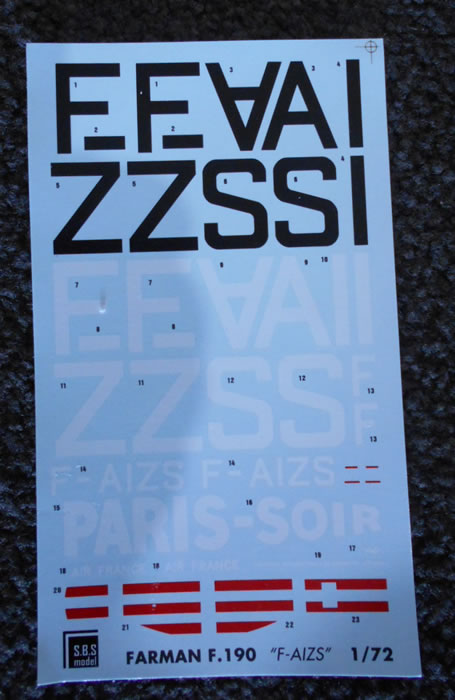
The three decal choices are all for the same aircraft - F-AIZS - at different times in her life:
-
CIDNA Airlines in 1932 with silver flying surfaces and orange fuselage and undercarriage struts, and a giant ‘Paris Soir’ logo under the fuselage - all markings are black or white,
-
Air France in overall blue with markings in white, and
-
Air France at Marseille in 1942 with blue fuselage and silver wings, with red and yellow striped nose and markings in white and black.
In summary, this is a lovely kit of an important between-the-wars light aircraft.
Care and planning in assembly and painting should result in a gorgeous addition to your collection.
Purchased by the reviewer from SBS Model
Review Text and Images Copyright © 2020 by Graham Carter
Page Created 25 August, 2020
Last updated
25 August, 2020
Back to HyperScale Main Page
Back to Reviews Page

|
